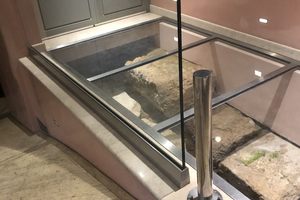Ancient Ruins on Selley Street in Athens, Greece

The Plaka area of Athens sits on the northern and eastern slopes of the Acropolis and is composed of narrow streets full of neoclassical buildings, Byzantine churches, and ancient ruins.
Examinations of artifacts from the area determined it was one of the first areas in Athens to be inhabited, populated as early as 7,000 BCE. The city has a long and complicated history, with Latin, Frankish, Venetian, Ottoman, Bavarian and other influences blended in with the centuries of Greek culture.
When Athens was liberated from the Ottomans in 1833 during the Greek War of Independence, there were only a few hundred houses in the Plaka. When Athens was declared the capital of Greece in 1834, the area experienced a construction boom. A large fire in 1884 slowed development, however, rebuilding began shortly thereafter. This growth continued with several interruptions due to archeological discoveries during the 1950s and 1970s. Construction slowed for several decades but picked up again with major infrastructure projects in preparation for the 2004 Summer Olympic Games. Several of these projects were designed to bury all underground utilities in the area. Almost all revealed various ruins and artifacts.
One project involved the construction of a multi-story building with subterranean parking on Selley 4, located in the heart of Plaka. During excavations for this project, a set of ancient ruins were revealed. Due to strict Greek laws protecting archaeological sites and artifacts, renovation plans were modified to protect the ruins. The new plans called for protective barriers to be placed around the structure(both subterranean and above ground) with reinforced glass flooring. This way, they can be admired from the walkway. Lighting was also added for better display.
The ruins are a great example of something hiding in plain site, as most rarely notice them.





